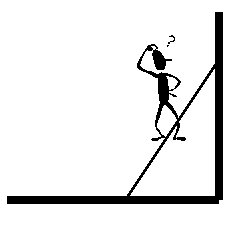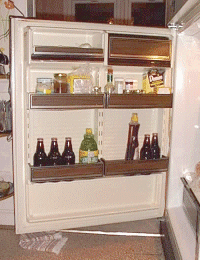
| Homework due Nov. 10 | Name: | Section: |
| A ladder is leaning against a wall as shown in the figure. If you were going to climb the ladder are you better off if there is no friction between the ladder and the wall or no friction between the ladder and the floor? Explain your answer in terms of the physics we have learned. Hint: Consider the conditions that must be met in order to keep the ladder from moving. |  |
Solution
The free-body diagram for a ladder leaning against a wall is shown in Fig. 8.13b. The forces shown are the normal forces from the wall and floor plus the ladder's weight. If the ladder slips, its center of mass will move down and to the left. If we consider the balance of forces, we see that the normal force from the floor has a chance of balancing the weight, but there is no force to balance the normal force from the wall. A friction force from the wall (not shown, would be pointing up at the top of the ladder) cannot balance the sidewards push. We need a friction from the floor. So we better have a rough floor, not a rough wall. Another way of looking at this is to consider the torque about the foot of the ladder. The normal force from the wall is necessary is to produce a torque around the foot of the ladder to balance the torque produced by the ladder's weight.
| My refrigerator has separate shelves on the door for storing bottles as shown in the picture at the right. Thin plastic straps keep the bottles from falling of the door. At one point when I had teenage children living in the house, one of them, under the influence of too much teenage energy and hormones, slammed the door with a bit too much vigor and a heavy bottle broke the strap. Do you think the bottle would be more likely to break the plastic strap if it is close to the hinge? close to the handle? or doesn't it matter? Explain your answer in terms of the physics we have learned. |
 |
Solution
Since both bottles are rotating on the door, which pivots about the hinge, a bottle anywhere on the door would move with the same angular velocity. But a bottle close to the hinge is moving with a smaller linear velocity than a bottle near the handle. If we assume that when the door comes up against the gasket everything has to stop in the same time, Δt, then by the impulse-momentum theorem, Δp = FnetΔt, the bottle with the larger momentum would require the larger force to stop it. Thus, the bottle near the handle feels the larger force from the strap. By Newton's 3rd law, Fstrap→bottle = Fbottle→strap this is the bottle that would exert the larger force on the strap and have more chance of breaking it. (And this is what happened. The part of the strap on the side of the door away from the hinge broke.)
In the figure below is shown one of the now common "rollerboard" suitcases on wheels first carried by airline flight crews. Suppose I've packed such a suitcase for a two-day trip. If it's lying in the position shown below, estimate how much force I would need to begin to tilt it upward onto its wheels using the handle. Be sure to clearly state your assumptions, since grading on this problem will be mostly based on your reasoning, not on your answer.

The wheel is pretty small so I'm going to assume the case is lying basically flat. The small angle shouldn't make much difference. I'm also going to assume the handle and the wheels don't contribute much to the weight of the suitcase so I'm going to ignore them.
The physics of what's going on is that to lift it I need to exert a force that will rotate it around the pivot at the wheel. This means that the counter-clockwise torque produced by my force will have to be greater (at least by a little) than the torque produced by the suitcase's weight that is trying to rotate it clockwise. The equation for this is:
That is, the weight of the suitcase times the distance it is acting from the pivot equals my force times the distance it acts from the pivot. I need to estimate 3 of these 4 quantities (W, dW, and dF) to solve for the fourth (F).
I estimate that the weight of the suitcase is about 30 pounds. This is about the same weight as my grandson. I know how heavy he is and it seems like about the same weight. The distance to my force is the whole length of the suitcase with the handle extended. When I stand next to it, that comes about 1 foot above my waist. I'm a bit shorter than 6 feet, so I estimate dF to be 4 feet. The weight of the suitcase acts at its center of mass. I estimate the suitcase's length to be 2 feet by thinking about how my foot would fit against the side of the suitcase (and how my shoes fit inside). This means that the distance to the pivot is about 1 foot. Balancing these gives
So the force I need is somewhere between about 5 and 10 pounds. Much less than the weight of the suitcase, thanks to the extra distance away from the pivot that I exert my force.